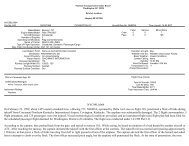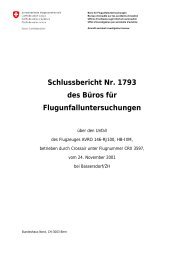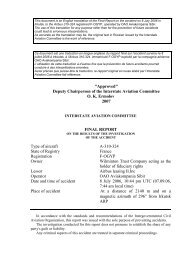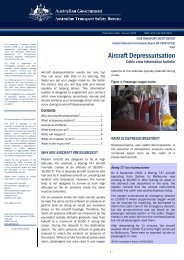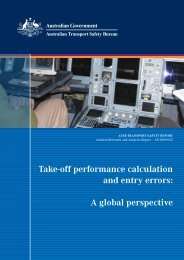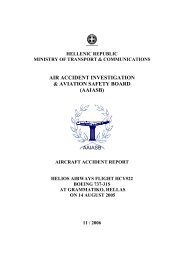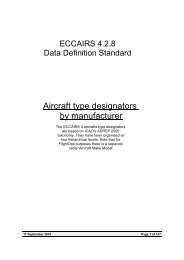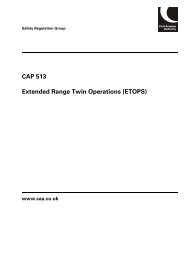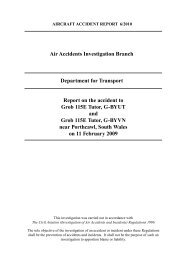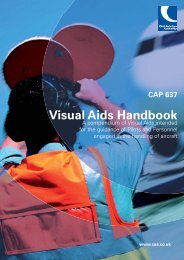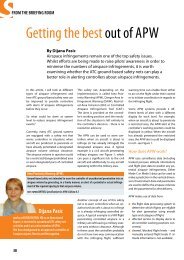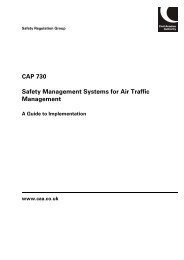CAP 772 - Birdstrike Risk Management for Aerodromes - SKYbrary
CAP 772 - Birdstrike Risk Management for Aerodromes - SKYbrary
CAP 772 - Birdstrike Risk Management for Aerodromes - SKYbrary
You also want an ePaper? Increase the reach of your titles
YUMPU automatically turns print PDFs into web optimized ePapers that Google loves.
<strong>CAP</strong> <strong>772</strong> <strong>Birdstrike</strong> <strong>Risk</strong> <strong>Management</strong> <strong>for</strong> <strong>Aerodromes</strong><br />
4.4 A safeguarding consultation process exists as part of the planning process1 to<br />
address proposed developments with the potential to affect the safety of aircraft<br />
operations at certain civil and military aerodromes, designated by the Government as<br />
"officially safeguarded aerodromes". The consultation process includes a means to<br />
address potential bird attractant developments within a 13 km radius circle of the<br />
aerodrome. Safeguarding maps are used to define the 13 km radius circle and are<br />
lodged with local planning authorities. The 13 km circle is based on a statistic that<br />
99% of birdstrikes occur below a height 2000 ft, and that an aircraft on a normal<br />
approach would descend into this circle at approximately this distance from the<br />
runway.<br />
4.5 All licensed aerodromes, other than those designated, should establish their own<br />
safeguarding consultation procedures with their local planning authorities.<br />
4.6 The following factors should be taken into consideration when assessing the potential<br />
increase in risk:<br />
a) the numbers, including seasonal variations, and types of birds that may be<br />
attracted to the development;<br />
b) any proposed landscaping or habitat designs;<br />
c) the distance from the aerodrome;<br />
d) the location of the development relative to aircraft arrival and departure flightpaths<br />
and within the visual circuit; and<br />
e) bird movements in relation to the aerodrome; <strong>for</strong> example, waterfowl move<br />
primarily between wetlands and along watercourses. Creating new bodies of<br />
water may cause more waterfowl movements and the increase of birdstrike risk.<br />
4.7 Ideally, in<strong>for</strong>mal discussions on a potential bird attractant development should take<br />
place between applicants and aerodrome safeguarders be<strong>for</strong>e the submission of a<br />
planning application. This may make it easier to achieve a mutually acceptable<br />
outcome with regard to birdstrike risk management.<br />
4.8 Where an assessment shows that the birdstrike risk may increase or could increase<br />
under certain conditions in the future, and the licence holder and developer are unable<br />
to agree a solution, an aerodrome operator could object to the planning application on<br />
safety grounds. Aerodrome operators may use local knowledge of bird populations<br />
and activities or an appropriate precedent of a similar safeguarding case to support<br />
the objection. The aerodrome operator may request that the objection cannot be<br />
withdrawn until measures to ensure there will be no increase in risk are implemented.<br />
It may be possible to modify a development (e.g. exclusion of food wastes from a<br />
new landfill) or impose planning conditions that require specific action to exclude birds<br />
or reduce their numbers (e.g. an effective BCMP). Where a safeguarding case is<br />
resolved through the imposition of planning conditions, it may be appropriate <strong>for</strong> the<br />
conditions (and a BCMP) to be subject to a legal agreement between the planning<br />
authority and the developer or property owner, or its successors.<br />
4.9 The BCMP should identify the aerodrome personnel holding responsibility <strong>for</strong> the<br />
assessment of a proposed development with the potential to attract birds.<br />
1. For England and Wales, a joint Town and Country Planning (Safeguarded <strong>Aerodromes</strong>, Technical Sites and Military<br />
Explosives Storage areas) Direction, came into <strong>for</strong>ce on 10 February 2003 (ODPM Circular and NAFW Circular1/2003<br />
refers); and in Scotland an essentially identical Scottish Planning Series Planning Circular 2/2003, was issued with the<br />
same effective date. Annex 1 of the Circulars describe the <strong>for</strong>mal consultation process and Annex 2 the various<br />
safeguarding aspects.<br />
1 September 2008<br />
Chapter 4 Page 15





